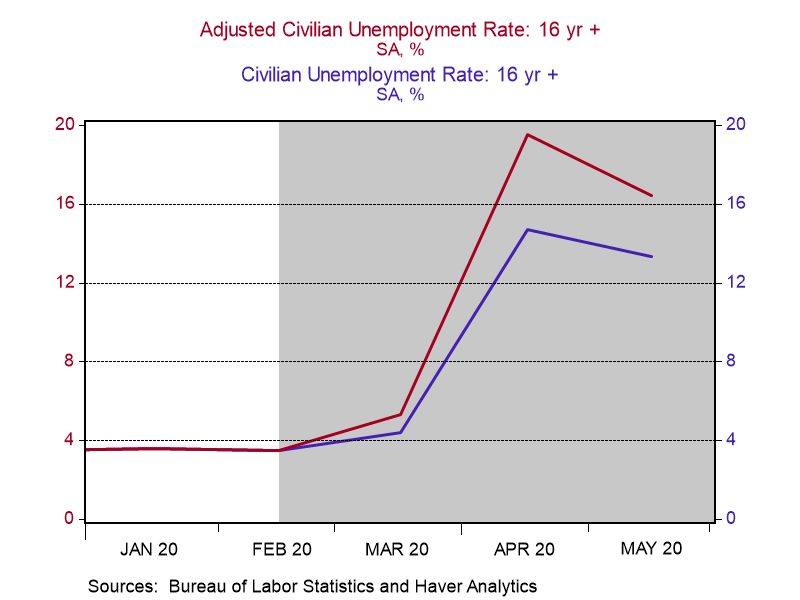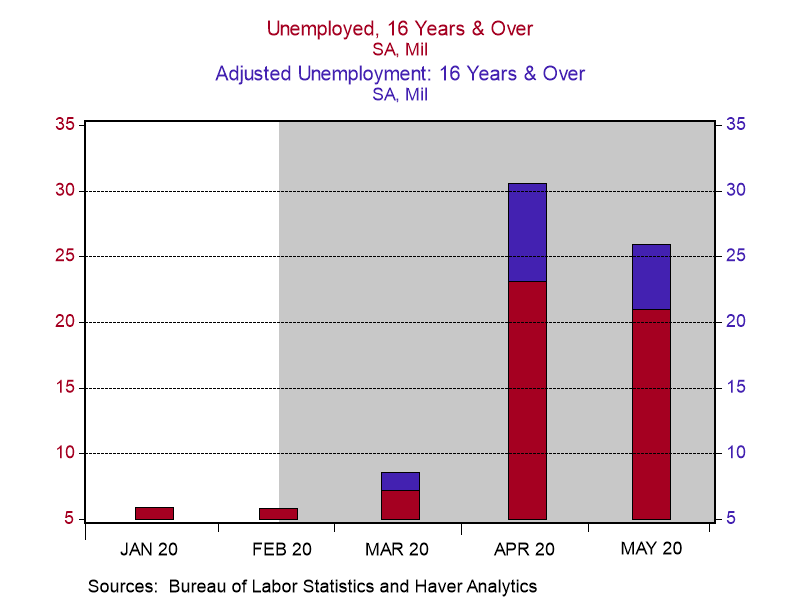 Global| Jun 08 2020
Global| Jun 08 2020Response to: BLS Failed Its Mandate: "Fearless Publication of the Facts"
Summary
In his Viewpoint commentary, Joseph Carson said the Bureau of Labor Statistics (BLS) "failed to live up to its mandate as it published two employment reports for April and May filled with distorted and corrupt data". He notes that [...]
In his Viewpoint commentary, Joseph Carson said the Bureau of Labor Statistics (BLS) "failed to live up to its mandate as it published two employment reports for April and May filled with distorted and corrupt data". He notes that "[s]ubstantial misclassifications of people working and not produced a 'false narrative' about jobs and unemployment in April and May". Specifically, "[i]n April, BLS found that 8.1 million people were wrongly classified as employed. In May, even with additional guidance to Census interviewers, BLS said 5.4 million people that were classified as employed but should have been classified as unemployed".
These statements are exaggerated, misleading, and inaccurate. The data are not corrupt, the misclassification is not certain and the numbers Carson stated are not correct – according to the BLS the estimated misclassification were 7.5 million in April and 4.9 million in May.
Let me start with the facts. The Household Survey, which produces the unemployment rate, classifies people as 'unemployed on temporary layoff' if they are furloughed/temporarily laid off and expecting recall. They numbered 17.9 million in April and 15.0 million in May (see table below). Workers who are on vacation, ill, or absent for 'other reasons' whether paid or unpaid, are classified as 'employed but absent from work'. There were 8.1 million workers in April and 5.4 million in May who were considered employed but absent from work for 'other reasons', which is the source of the numbers Carson cites in his commentary. BLS notes that their "analysis of the underlying data suggests that this group included workers affected by the pandemic response who should have been classified as unemployed on temporary layoff" (authors highlight).
However, even in normal circumstances there are employed workers who absent from work for 'other reasons'. In the previous four years, that number averaged 620,000 in April and 549,000 in May, which means that the size of Carson's misclassification, and subsequent unemployment rates are incorrect. Instead, BLS estimates 7.5 million misclassified unemployed in April and 4.9 million in May, or an adjusted unemployment rate of 19.5% in April and 16.4% in May (see table below which also includes data for March as it also had some misclassification - for research purposes Haver Analytics has calculated adjusted series which can be found in the USECON database).
Carson says "BLS decision to publish distorted and misleading figures is based on a long-standing policy. BLS stated, 'According to usual practice, the data from the household survey are accepted as recorded. To maintain data integrity, no ad hoc actions are taken to reassign survey responses". The BLS gave guidance to surveyors on how to avoid this type of error for the March and April employment reports. And as Carson notes, following the April report they gave additional training. What he fails to acknowledge is that the data improved as Erica Groshen notes, the share of adjusted unemployed on temporary layoff who were misclassified declined to 25% in May from 30% in April and 39% in March.
Not surprisingly, given the fluidity of the economic situation, the problem still persists to a great degree. I agree with Carson that the BLS could have done a better job at highlighting the issue and the adjusted unemployment rate – though the economics community and financial press seems have picked-up on it quickly. However, where I strongly disagree is with changing the official statistics based on an imperfect estimate of the error. Should the BLS start adjusting responses to the survey that they believe are incorrect? That would be an actual corruption of the data, which would lead to mistrust of what are currently the Gold Standard of economic statistics.
| Estimated Misclassification and Its Impact on the Unemployment Rate | May | April | March |
|---|---|---|---|
| Unemployed on temporary layoff (NSA, millions) | 15.0 | 17.9 | 2.2 |
| BLS Estimate of workers on temporary layoff who were misclassified as 'employed but absent from work' (NSA, mil.) | 4.9 | 7.5 | 1.4 |
| Estimated Error (%) | 25.0 | 30.0 | 39.0 |
| Official Unemployment Rate (SA, %) | 13.3 | 14.7 | 4.4 |
| BLS Adjusted unemployment rate based on estimated misclassified workers (%) | 16.4 | 19.5 | 5.3 |
Gerald D. Cohen
AuthorMore in Author Profile »Gerald Cohen provides strategic vision and leadership of the translational economic research and policy initiatives at the Kenan Institute of Private Enterprise.
He has worked in both the public and private sectors focusing on the intersection between financial markets and economic fundamentals. He was a Senior Economist at Haver Analytics from January 2019 to February 2021. During the Obama Administration Gerald was Deputy Assistant Secretary for Macroeconomic Analysis at the U.S. Department of Treasury where he helped formulate and evaluate the impact of policy proposals on the U.S. economy. Prior to Treasury, he co-managed a global macro fund at Ziff Brothers Investments.
Gerald holds a bachelor’s of science from the Massachusetts Institute of Technology and a Ph.D. in Economics from Harvard University and is a contributing author to 30-Second Money as well as a co-author of Political Cycles and the Macroeconomy.







